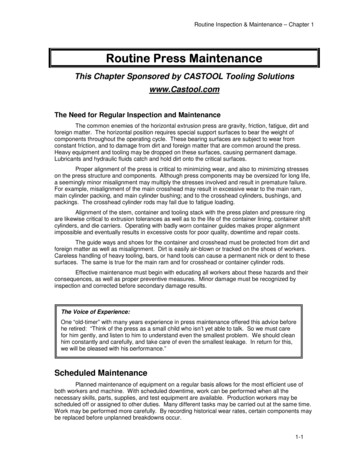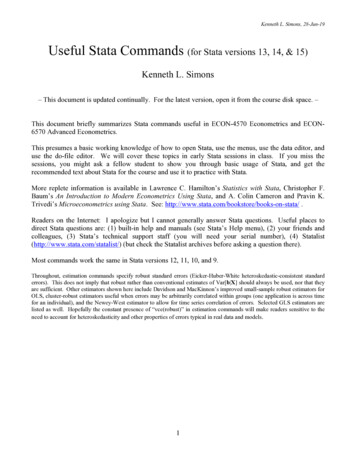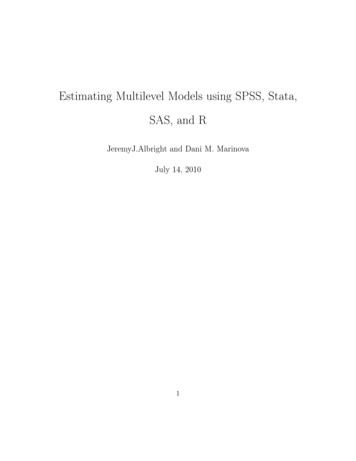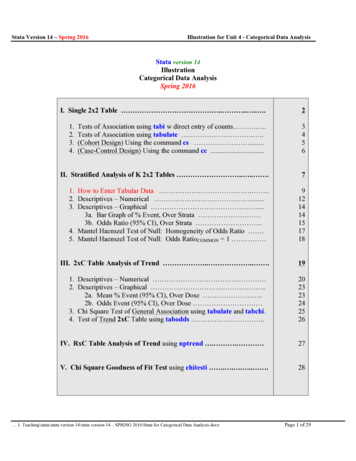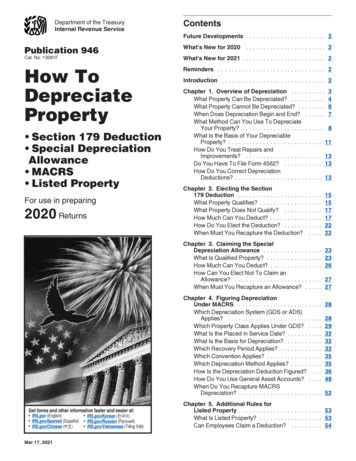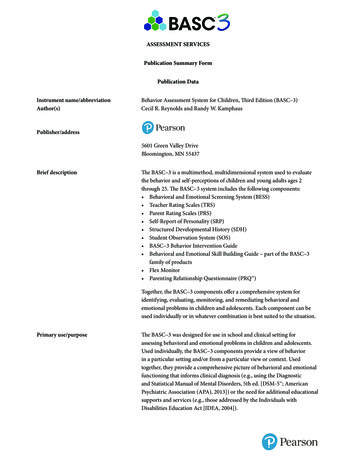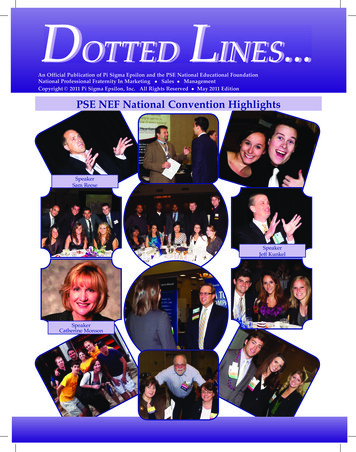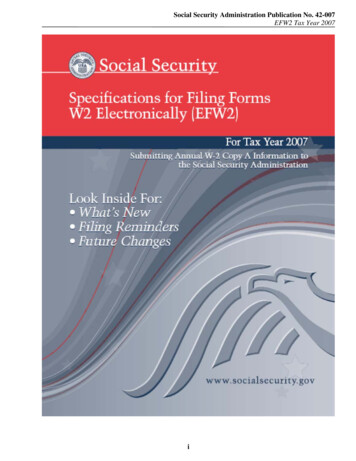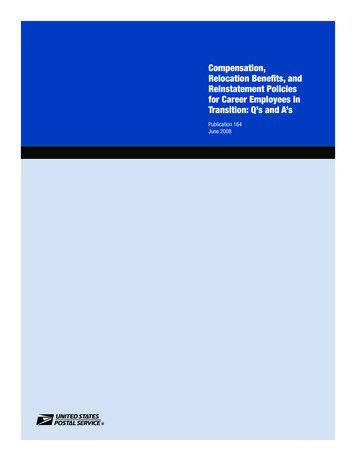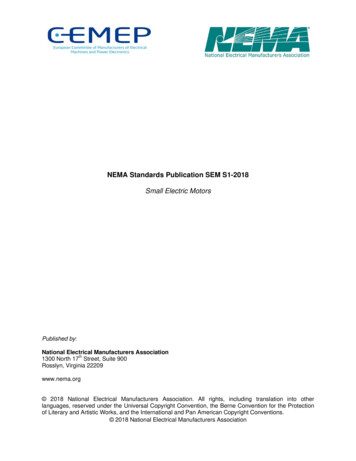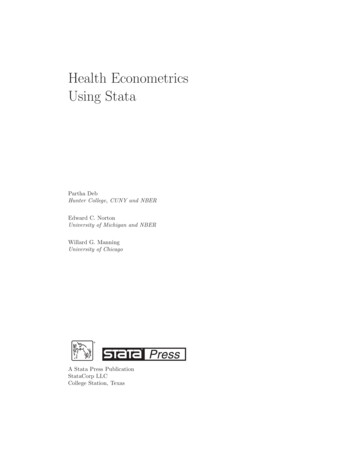
Transcription
Health EconometricsUsing StataPartha DebHunter College, CUNY and NBEREdward C. NortonUniversity of Michigan and NBERWillard G. ManningUniversity of Chicago A Stata Press PublicationStataCorp LLCCollege Station, Texas
Copyright c 2017 StataCorp LLCAll rights reserved. First edition 2017Published by Stata Press, 4905 Lakeway Drive, College Station, Texas 77845Typeset in LATEX 2εPrinted in the United States of America10 9 8 7 6 5 4 3 2 8-1-59718-230-0Library of Congress Control Number: 2016960172No part of this book may be reproduced, stored in a retrieval system, or transcribed, in anyform or by any means—electronic, mechanical, photocopy, recording, or otherwise—withoutthe prior written permission of StataCorp LLC., Stata Press, Mata,Stata,StataCorp LLC., and NetCourse are registered trademarks ofStata and Stata Press are registered trademarks with the World Intellectual Property Organization of the United Nations.NetCourseNow is a trademark of StataCorp LLC.LATEX 2ε is a trademark of the American Mathematical Society.
Dedication toWillard G. Manning, Jr. (1946–2014)Will Manning joined the RAND Corporation in 1975, a few years after completinghis PhD at Stanford. He quickly became involved in the RAND Health Insurance Experiment. Will was the lead author of the article that reported the main insuranceresults in the 1987 American Economic Review, one of the most cited and influentialarticles in health economics. He also published many seminal articles about demand foralcohol and cigarettes, the taxes of sin, and mental healthcare. In 2010, the AmericanSociety of Health Economics awarded the Victor R. Fuchs Award to Will for his lifetimecontributions to the field of health economics.But perhaps his strongest influence was on empirical methods central to appliedhealth economics research. With others at RAND, he advocated moving away fromtobit and sample-selection models to deal with distributions of dependent variablesthat had a large mass at zero. The two-part model, in all of its forms, is now thedominant model for healthcare expenditures and use. He also understood the power andlimitations of taking logarithms of skewed distributions. And woe to the author who didnot deal adequately with heteroskedasticity upon retransformation. Will continued topush the field of health econometrics through the end of his career. He helped developnew methods and advocated the work of others who found better ways of modelinghealthcare expenditures and use. His influence on applied health economics is deep andlasting (Konetzka 2015; Mullahy 2015).Will had three other characteristics that we grew to appreciate, if not emulate,over the years. He was absolutely meticulous about research—data, methods, andattribution. Precision is not merely an abstract statistical concept but an essential partof all steps in a research project.Will was extraordinarily generous with his time. We know of many junior economistswho were amazed and profoundly grateful that Will took the time to give detailedfeedback on their article or presentation—and to explain why their standard errorswere all wrong.Finally, Will was hilariously funny. We know this is a rare trait in an economist, buta little levity makes the daily give and take in search of truth that much more enjoyable.We dedicate this book to our friend and colleague, Will Manning.Partha Deb and Edward C. Norton
ContentsList of tablesxiiiList of figuresxvPrefacexviiNotation and typography12Introductionxix11.1Outline. . . . . . . . . . . . . . . . . . . . . . . . . . . . . . . . . .21.2Themes . . . . . . . . . . . . . . . . . . . . . . . . . . . . . . . . . .31.3Health econometric myths . . . . . . . . . . . . . . . . . . . . . . . .41.4Stata friendly . . . . . . . . . . . . . . . . . . . . . . . . . . . . . . .51.5A useful way forward . . . . . . . . . . . . . . . . . . . . . . . . . . .6Framework72.1Introduction . . . . . . . . . . . . . . . . . . . . . . . . . . . . . . . .72.2Potential outcomes and treatment effects . . . . . . . . . . . . . . . .92.3Estimating ATEs . . . . . . . . . . . . . . . . . . . . . . . . . . . . .102.3.1A laboratory experiment . . . . . . . . . . . . . . . . . . . .112.3.2Randomization . . . . . . . . . . . . . . . . . . . . . . . . .112.3.3Covariate adjustment . . . . . . . . . . . . . . . . . . . . . .12Regression estimates of treatment effects . . . . . . . . . . . . . . . .132.4.1Linear regression . . . . . . . . . . . . . . . . . . . . . . . .132.4.2Nonlinear regression . . . . . . . . . . . . . . . . . . . . . .152.5Incremental and marginal effects . . . . . . . . . . . . . . . . . . . .162.6Model selection . . . . . . . . . . . . . . . . . . . . . . . . . . . . . .182.6.1In-sample model selection . . . . . . . . . . . . . . . . . . .192.6.2Cross-validation . . . . . . . . . . . . . . . . . . . . . . . . .202.4
viiiContents2.73421MEPS data233.1Introduction . . . . . . . . . . . . . . . . . . . . . . . . . . . . . . . .233.2Overview of all variables . . . . . . . . . . . . . . . . . . . . . . . . .243.3Expenditure and use variables . . . . . . . . . . . . . . . . . . . . . .263.4Explanatory variables . . . . . . . . . . . . . . . . . . . . . . . . . .303.5Sample dataset . . . . . . . . . . . . . . . . . . . . . . . . . . . . . .323.6Stata resources . . . . . . . . . . . . . . . . . . . . . . . . . . . . . .32The linear regression model: Specification and checks334.1Introduction . . . . . . . . . . . . . . . . . . . . . . . . . . . . . . . .334.2The linear regression model . . . . . . . . . . . . . . . . . . . . . . .344.3Marginal, incremental, and treatment effects . . . . . . . . . . . . . .354.3.1Marginal and incremental effects . . . . . . . . . . . . . . .364.3.2Graphical representation of marginal and incremental effects384.3.3Treatment effects . . . . . . . . . . . . . . . . . . . . . . . .41Consequences of misspecification . . . . . . . . . . . . . . . . . . . .474.4.1Example: A quadratic specification . . . . . . . . . . . . . .474.4.2Example: An exponential specification . . . . . . . . . . . .50Visual checks . . . . . . . . . . . . . . . . . . . . . . . . . . . . . . .524.5.1Artificial-data example of visual checks . . . . . . . . . . . .524.5.2MEPS example of visual checks . . . . . . . . . . . . . . . .55Statistical tests . . . . . . . . . . . . . . . . . . . . . . . . . . . . . .584.6.1Pregibon’s link test . . . . . . . . . . . . . . . . . . . . . . .584.6.2Ramsey’s RESET test . . . . . . . . . . . . . . . . . . . . .594.6.3Modified Hosmer–Lemeshow test . . . . . . . . . . . . . . .594.6.4Examples . . . . . . . . . . . . . . . . . . . . . . . . . . . .604.6.5Model selection using AIC and BIC . . . . . . . . . . . . . .66Stata resources . . . . . . . . . . . . . . . . . . . . . . . . . . . . . .694.44.54.64.75Other issues . . . . . . . . . . . . . . . . . . . . . . . . . . . . . . . .Generalized linear models715.171Introduction . . . . . . . . . . . . . . . . . . . . . . . . . . . . . . . .
Contents5.26ixGLM framework . . . . . . . . . . . . . . . . . . . . . . . . . . . . .735.2.1GLM assumptions . . . . . . . . . . . . . . . . . . . . . . . .735.2.2Parameter estimation . . . . . . . . . . . . . . . . . . . . . .755.3GLM examples . . . . . . . . . . . . . . . . . . . . . . . . . . . . . .755.4GLM predictions . . . . . . . . . . . . . . . . . . . . . . . . . . . . .775.5GLM example with interaction term . . . . . . . . . . . . . . . . . .785.6Marginal and incremental effects . . . . . . . . . . . . . . . . . . . .815.7Example of marginal and incremental effects . . . . . . . . . . . . . .825.8Choice of link function and distribution family . . . . . . . . . . . .855.8.1AIC and BIC . . . . . . . . . . . . . . . . . . . . . . . . . .855.8.2Test for the link function . . . . . . . . . . . . . . . . . . . .875.8.3Modified Park test for the distribution family . . . . . . . .895.8.4Extended GLM . . . . . . . . . . . . . . . . . . . . . . . . .915.9Conclusions . . . . . . . . . . . . . . . . . . . . . . . . . . . . . . . .915.10Stata resources . . . . . . . . . . . . . . . . . . . . . . . . . . . . . .91Log and Box–Cox models936.1Introduction . . . . . . . . . . . . . . . . . . . . . . . . . . . . . . . .936.2Log models . . . . . . . . . . . . . . . . . . . . . . . . . . . . . . . .946.2.1946.3Retransformation from ln(y) to raw scale. . . . . . . . . . . . . . .966.3.1Error retransformation and model predictions . . . . . . . .966.3.2Marginal and incremental effects . . . . . . . . . . . . . . .996.4Comparison of log models to GLM . . . . . . . . . . . . . . . . . . .996.5Box–Cox models . . . . . . . . . . . . . . . . . . . . . . . . . . . . . 1016.5.16.67Log model estimation and interpretation . . . . . . . . . . .Box–Cox example . . . . . . . . . . . . . . . . . . . . . . . . 101Stata resources . . . . . . . . . . . . . . . . . . . . . . . . . . . . . . 102Models for continuous outcomes with mass at zero1057.1Introduction . . . . . . . . . . . . . . . . . . . . . . . . . . . . . . . . 1057.2Two-part models . . . . . . . . . . . . . . . . . . . . . . . . . . . . . 1067.2.1Expected values and marginal and incremental effects . . . . 108
xContents7.3Generalized tobit . . . . . . . . . . . . . . . . . . . . . . . . . . . . . 1097.3.17.4Comparison of two-part and generalized tobit models . . . . . . . . . 1117.4.17.57.68Full-information maximum likelihood and limited-informationmaximum likelihood . . . . . . . . . . . . . . . . . . . . . . 110Examples that show similarity of marginal effects . . . . . . 112Interpretation and marginal effects . . . . . . . . . . . . . . . . . . . 1167.5.1Two-part model example . . . . . . . . . . . . . . . . . . . . 1167.5.2Two-part model marginal effects . . . . . . . . . . . . . . . 1187.5.3Two-part model marginal effects example . . . . . . . . . . 1207.5.4Generalized tobit interpretation . . . . . . . . . . . . . . . . 1227.5.5Generalized tobit example . . . . . . . . . . . . . . . . . . . 122Single-index models that accommodate zeros . . . . . . . . . . . . . 1287.6.1The tobit model . . . . . . . . . . . . . . . . . . . . . . . . . 1287.6.2Why tobit is used sparingly . . . . . . . . . . . . . . . . . . 1307.6.3One-part models . . . . . . . . . . . . . . . . . . . . . . . . 1317.7Statistical tests . . . . . . . . . . . . . . . . . . . . . . . . . . . . . . 1317.8Stata resources . . . . . . . . . . . . . . . . . . . . . . . . . . . . . . 132Count models1338.1Introduction . . . . . . . . . . . . . . . . . . . . . . . . . . . . . . . . 1338.2Poisson regression . . . . . . . . . . . . . . . . . . . . . . . . . . . . . 1378.38.2.1Poisson MLE . . . . . . . . . . . . . . . . . . . . . . . . . . 1378.2.2Robustness of the Poisson regression . . . . . . . . . . . . . 1388.2.3Interpretation . . . . . . . . . . . . . . . . . . . . . . . . . . 1398.2.4Is Poisson too restrictive? . . . . . . . . . . . . . . . . . . . 142Negative binomial models . . . . . . . . . . . . . . . . . . . . . . . . 1448.3.18.4Examples of negative binomial models . . . . . . . . . . . . 146Hurdle and zero-inflated count models . . . . . . . . . . . . . . . . . 1498.4.1Hurdle count models . . . . . . . . . . . . . . . . . . . . . . 1498.4.2Zero-inflated models . . . . . . . . . . . . . . . . . . . . . . 155
Contentsxi8.5Truncation and censoring . . . . . . . . . . . . . . . . . . . . . . . . 1588.698.5.1Truncation . . . . . . . . . . . . . . . . . . . . . . . . . . . . 1588.5.2Censoring . . . . . . . . . . . . . . . . . . . . . . . . . . . . 159Model comparisons . . . . . . . . . . . . . . . . . . . . . . . . . . . . 1598.6.1Model selection . . . . . . . . . . . . . . . . . . . . . . . . . 1608.6.2Cross-validation . . . . . . . . . . . . . . . . . . . . . . . . . 1618.7Conclusion . . . . . . . . . . . . . . . . . . . . . . . . . . . . . . . . . 1638.8Stata resources . . . . . . . . . . . . . . . . . . . . . . . . . . . . . . 163Models for heterogeneous effects9.1Introduction . . . . . . . . . . . . . . . . . . . . . . . . . . . . . . . . 1659.2Quantile regression . . . . . . . . . . . . . . . . . . . . . . . . . . . . 1669.39.49.2.1MEPS examples . . . . . . . . . . . . . . . . . . . . . . . . . 1679.2.2Extensions . . . . . . . . . . . . . . . . . . . . . . . . . . . . 173Finite mixture models . . . . . . . . . . . . . . . . . . . . . . . . . . 1739.3.1MEPS example of healthcare expenditures . . . . . . . . . . 1769.3.2MEPS example of healthcare use . . . . . . . . . . . . . . . 186Nonparametric regression . . . . . . . . . . . . . . . . . . . . . . . . 1929.4.110165MEPS examples . . . . . . . . . . . . . . . . . . . . . . . . . 1939.5Conditional density estimator . . . . . . . . . . . . . . . . . . . . . . 1989.6Stata resources . . . . . . . . . . . . . . . . . . . . . . . . . . . . . . 200Endogeneity20110.1Introduction . . . . . . . . . . . . . . . . . . . . . . . . . . . . . . . . 20110.2Endogeneity in linear models . . . . . . . . . . . . . . . . . . . . . . 20210.310.2.1OLS is inconsistent . . . . . . . . . . . . . . . . . . . . . . . 20210.2.22SLS . . . . . . . . . . . . . . . . . . . . . . . . . . . . . . . 20410.2.3Specification tests . . . . . . . . . . . . . . . . . . . . . . . . 20610.2.42SRI . . . . . . . . . . . . . . . . . . . . . . . . . . . . . . . 20710.2.5Modeling endogeneity with ERM . . . . . . . . . . . . . . . 209Endogeneity with a binary endogenous variable . . . . . . . . . . . . 21010.3.1Additional considerations . . . . . . . . . . . . . . . . . . . 216
xii11Contents10.4GMM . . . . . . . . . . . . . . . . . . . . . . . . . . . . . . . . . . . 21610.5Stata resources . . . . . . . . . . . . . . . . . . . . . . . . . . . . . . 219Design effects22111.1Introduction . . . . . . . . . . . . . . . . . . . . . . . . . . . . . . . . 22111.2Features of sampling designs . . . . . . . .
Jun Li, and Eden Volkov for reading early drafts and providing critical feedback. We thank the many conference participants who were the early guinea pigs for our efforts at clarity and instruction and especially those who gave us the initial motivation to undertake this book. Our wives, Erika Bach and Carolyn Norton, provided support and encouragement, especially during periods of low .
